#elorg
Text

47 notes
·
View notes
Video
youtube
🎮 Tetris (Game Boy)
Complete Gameplay: https://youtu.be/RwD8iRHKLME
#Tetris #GameBoy #Nintendo #BulletProof #Movie #NGB #Elorg #Puzzle #AlexeyPajitnov #Filme #HenkRogers #任天堂 #ゲームボーイ #Viciogame #Gameplay #Walkthrough #Playthrough #Longplay #LetsPlay
#tetris#gameboy#game boy#nintendo.#bullet-proof#movie#ngb#elorg#puzzle#alexey pajitnov#filme#henk rogers#viciogame#gameplay#walkthrough#playthrough#longplay#let's pl#任天堂#ゲームボーイ
3 notes
·
View notes
Text
Tetris turned 38 years old; check out the details of the success story of the game
Tetris turned 38 years old; check out the details of the success story of the game
Credits: Shutterstock
The electronic game tetris turned 38 on the 6th, and I think that this timeless game deserves to be remembered, at least some fragments of its history, after all, it is a title created in 1984 in the most unusual way possible and in the middle of the cold war, but that it remains relevant even today.
raised by Alexey Pajitnova software engineer at soviet academy of…

View On WordPress
#Alexey Pajitnov#Andromeda#big n#CNN#electrical engineering#electronics 60#elorg#family#game boy#henk rogers#Nintendo#personal computer#Robert Stein#Soviet Union#tetris#tetris company#Vadim Gerasimov#Youtube
2 notes
·
View notes
Text
Henk Roger in Chile
Henk Roger (actual CEO with Axeley Pajitnov of The Tetris Company), is a Game Programmer, Game Designer, various games, and Chief Executive of game companies, he arrived in Chile for Festigame 2023 on the 12 and 13 of August!
I went on Saturday and I got to know him, he could sign me some Bullet Proof Software (best known as B.P.S too) games.
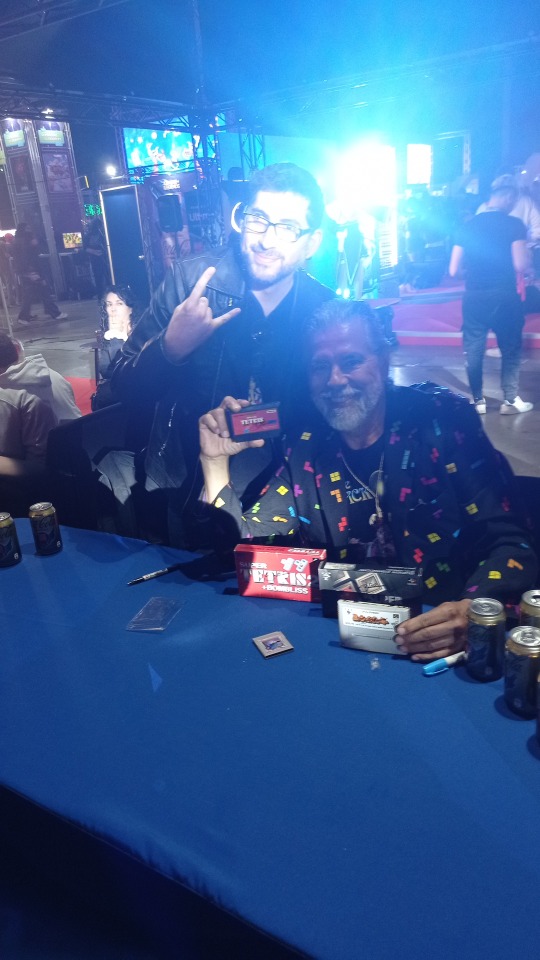


Was so fantastic his interview on the main stage of FestiGames.
I will tell you the trajectory of Henk Roger before and later of Tetris.
The Birth of Bullet Proof Software

Bullet Proof Software (known as B.P.S) was an American/Japanese game Developer and Publisher founded by Henk Roger in 1983 in Japan. In the next year, the first game developed by B.P.S was Black Onyx, which was the first introduction of the RPG (Role Playing Game)/ Dungeon Crawler genre for the gamer Japanese before they developed games such as Dragon Quest (Enix), YS (Nihon Falcom) or Final Fantasy (Squaresoft).
Black Onyx had Inspiration from successful American RPGs like Ultima by Richard Garriot in 1981, and Wizardry by Andrew C. Greenberg and Robert Woodhead in 1981, obviously, those games are based on Dungeon & Dragon (a tabletop game created in 1974 by David Gygax and Dave Anderson), the original mother of all Rol Playing games.
Its development was for NEC-PC 88, NEC-PC 98, SEGA-1000 and, and had a sequel for Famicom called Super Black Onyx.



"Black Onyx for NEC PC 88 (hardware Japanese of 8 bits)"

"The Original Team of B.P.S during the development of Black Onyx in 1984"



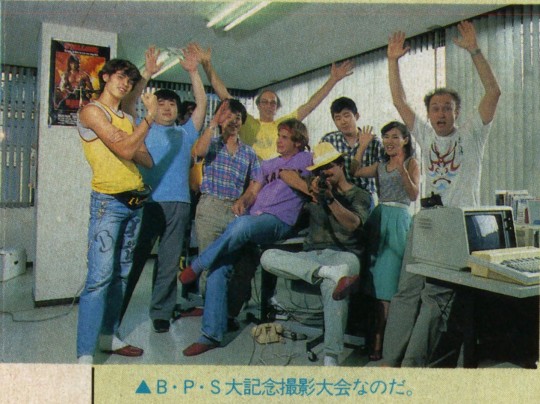
"Bullet Proof Software Office in 1984, the screenshots are of a Japanese Magazine called Beep! about videogame, 1984 which they worked on in Black Onyx's Third chapter, showed GDD and Sprite Editor that was unreleased". (source by VGDenetsu)


B.P.S Club Ad, show the next game for PC 88 and Famicom like:
-MicroGo1 (1987 developed by B.P.S for Famicom) is a Go game
-Archon (they were the publisher for the PC 88/FM 77 version in 1986)
-Lyrane (they were the publisher for the PC 88/FM 77 version in 1986 and 1987)
Tetris, From Russia with Love:
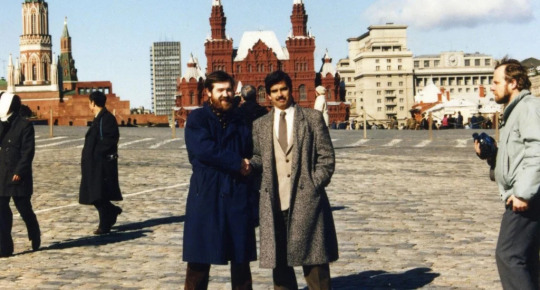
I suggest you check the great documental: "From Russian with Love" created by BBC, but I will try to resume the story:
Axeley Pajitnov's 1985 program Tetris his Electronika 60 in the Science Sovietic Academy of Moscu during the URRS, his creation did not have the proprietary right concept, the game was spread all over Europe.
The game quickly arrived on different PCs until you reached a Computation Exposition in Europe.
A man called Robert Stein from Andromeda Software was interested in Tetris, and he wanted to contact Axeley Pajitnov, but the Soviet government was awarded the game to negotiate with any wanted of getting the rights of commercialization for selling Tetris via Elorg, Ministry of Technology of the government.
Elorg sent the first step for negotiating to Robert Stein, but him
believed that was a contract for the right of commercialization, he started selling the rights commercialization to Mirror Soft (a British Company created by the Multibilionaire Robert Maxwell), This company sold the rights to Spectrum Holobyte (game developer and Publisher in the USA) that this sold the rights to Atari Tengen (for Arcade and Console) and finally Atari Tengen sold the rights to Henk Roger from Bullet Proof Software for can sell Tetris for Famicom, during a CES of 1987.
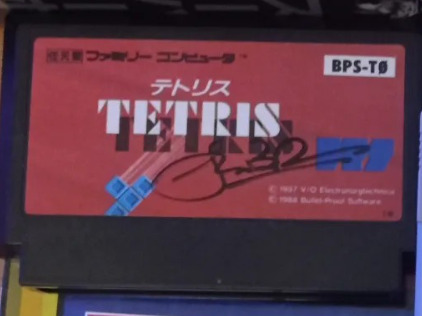
"This was the first version of Tetris for Famicom released in 1987, that didn't same NES version released in 1989 was developed by Nintendo Japan".
But Elorg didn´t know about the commercialization of Tetris in anything platform until 1988, when they saw the different Tetris versions on PC.
Elorg contacted Robert Stein because he traded the rights without Elorg's permission., while Mirror Soft at the same time they wanted the rights to Tetris, and Henk Roger was contacted by Hiroshi Yamauchi because Nintendo they worked on a new Console Portable: Game Boy.
Henk Roger, Robert Stein, and Kevin Maxwell made a trip to URRS, to negotiate the complete rights of Tetris, without knowing each one traveled with the same intention, was a legal fight and very bureaucratic, and this scaled to the KGB, Kremlin, and finally to the Mijain Gorbachov, but Henk Roger got the exclusive rights for develop and sell the game for Game Boy and VideoGame Home Console.
With the rights to the Video Game Home Console, They can stop and cancel the version of Atari Tengen for NES, obviously, Atari demanded Nintendo in a Legal Trial for the rights to sell the Home Console (at this moment ATARI made a re-engineer inverse to the NES for manufacture own NES Cartridge without permission of Nintendo they had another legal trial).

In 1989, Tetris was sold with the release of the Game Boy, which was developed by Bullet Proof Sofware, It was a success for Nintendo and BPS, but Axeley Pajitnov at all times earned nothing from the profits of his creation, Elorg and URRS kept the profits until 1996 when Russia change to the capitalist system and rights of creation were delivered for his creator.
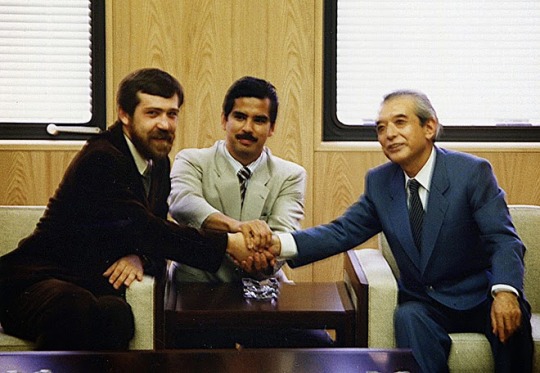
Axeley Pajitnov, Henk Roger and Hiroshi Yamauchi (President of Nintendo Kyoto in 1989)
Testris and the Friendship:
Axeley Pajitnov wanted to work as a Game designer and work in the game industry, and his best friend could help.
Bullet Proof Software since 1989, opened a filial of development in Redmond Washington (very near the Nintendo of America office), Axeley Pajitnov could exit to the URRS, and traveled to the United States with his family.
His first work in B.P.S was:
- WellTris
- FaceTris
- HaTris
- Knight Moves
- PipeDream ( based on the PC game of Lucas Film Game)
- Yoshi Cookies (based on an unreleased arcade game of HomeData)
Later Pajitnov worked at Microsoft and in 1996 he founded with Henk Roger, The Tetris Company.


"Hatris and PipeDream was the next game designed by Axeley Pajitnov after Tetris, Facetris & Welltris"

"An article from 1990 by GamePro Magazine (Review of Hatris & Pipe Dreams Puzzle Games for Game Boy)"

"Club Nintendo Magazine, CES of 1993"


"Ads of some Game of Bullet Proof Software".
2 notes
·
View notes
Text
Interesting, they removed the mention of ELORG in the title screen of GB Tetris on Nintendo Switch Online.
2 notes
·
View notes
Text
ここ数年間、まるでSF小説やSF映画を観ているような感覚になることが何度もあった。エプスタイン事件に関する話題のような、なんだかよくわからない話を聞いてる時などが典型的な例だが、ミステリーやサスペンスとかホラーというより、なぜかSFっぽく感じる。主観的だし個人的で感覚的なことで、いきなりそんなこと話し出されてもって感じなことだってのはかろうじてわかるぐらいで、自分でも何言ってんのかあまりわかっていないが、例えば、去年のちょうど今くらいの時期に、『テトリス』というゲームが開発されて世界に広まるまでの出来事についての動画を観た。動画を観始めて、へーそうなんだすげーとか思っているうちに、アホなことにそもそもなぜその動画を観ようと思ったのかをすっかり忘れてしまったが、色々発見があったというか、知らなかったことを知れたみたいな満足感があった。動画を観終わって、よく見るネット掲示板を眺めていたら、「こないだテトリスについての動画を観たんだけど」という書き込みがあり、そこに今さっき観終わった動画のリンクが貼られていた。それで、もちろん、なんかぞわっとした。その書き込みがシェアしたかった情報というのも、その動画を観て初めて知ってなんかすげーとか思ってたところだった。その書き込みに対して、ちょうど今まさになぜかその動画観たんだけどってレスをつけたかったが、何て言えばいいのかとか考えてるうちに、ってか一番聞きたくなったのはそもそもなんで自分はその動画を観ようと思ったのかということだけど、そんなこといきなり言い出すのもさすがにイカレすぎてるか、とか考えてるうちにその板(スレッド)は流れていった。
強引に理屈づけ��と、ある程度興味や関心と情報を共有すると、似たようなタイミングで似たような発想をすることがあるというのはあり得る話だし、それをテレビアニメ『攻殻機動隊 S.A.C.』に出てくる、「孤立した個人(スタンドアローン)でありながら、全体として集団的な行動(コンプレックス)を取ること」を意味する「スタンドアローンコンプレックス」という用語で呼ぶのも、無理にSFっぽい方に寄せててちょっと大袈裟かなとも思う。同じライブ動画を観ながらコメントをやり合っているときには、同じタイミングで同じ言葉を書き込むこと、つまりはコメントが被るってことはよくあるし、そういうのを「ハイブマインド(集合精神)だ」とか言って面白がったりもするが、ちょい恥ずくもある。
それ以降、偶然って何なんだろうって考えるというか、考えたところでわかるわけはないということはわかってるというか、何なのかわかったらそれは偶然とは言えないっしょみたいなことが、どこかに引っ掛かっているような感じで、SFを観ているように感じる感覚の一部になっていった。要するに、自分でも何言ってんのかあまりわかっていないため何が要するになのかもわからないが、「偶然」は、ランダム性や未知の領域と、整理された情報による既知の領域が、折り重なるように同時に存在するときに発生するのだと考えると、ランダムに落ちてくるブロックを並べていくテトリスに似ていると言えないだろうか。SFを観てるような感覚というのの一つも、色んなことがどういうわけか何らかの形で繋がっているように思えてくるというような感じでもあるが、いやそれも、思い浮かんだものを無理に一つに結びつけようとするあまり、何言ってんのかますますわからなくなっているだけかもしれない。
去年観たテトリスの動画というのは、ソ連のコンピュータ科学者アレクセイ パジトノフにより1984年に考案されたコンピュータゲーム『テトリス』が、1987年には西側諸国でもブームになるが、1989年にライセンスが問題になり、アタリゲームズの子会社であるテンゲンと任天堂との間で裁判になるという、「テトリス事件」とも呼ばれる一連の出来事を解説したもので、その動画を観て初めて知ってなんかすげーとか思ったところというは、テトリスを西側諸国に広めたキーパーソンが、ロバート マクスウェルという人物だったということだ。
ロバート マクスウェルは巨大メディアコングロマリットを築き上げたメディア王であり、ジェフリー エプスタインの共犯者で現在服役中のギレーヌ マクスウェルの父親である。
1980年代当時のソ連は「鉄のカーテン」で閉ざされた状態であり、ハンガリーが西側諸国とソ連との交流地点となっていた。ハンガリーのソフトウェア企業であるアンドロメダソフトウェアのオーナーが、ソ連の研究所などコンピュータが使えるあらゆる場所で、見たことのないゲーム、すなわち『テトリス』が大流行していることを知り、自身でもプレイしてみた。彼はゲーマーではなかったが、一度プレイし始めるとやめられなくなるほど面白く、中毒性に驚き、売れると確信した。アンドロメダはテトリスを、マクスウェルのメディア帝国の中のゲームソフト会社であるミラーソフトに、ソ連との明確な契約がないまま売り込んだ。これが後にライセンス問題として浮上することになる。ミラーソフトがアタリにサブライセンスを認可し、アタリがその子会社であるテンゲンにサブライセンスを認可する形となる。
1988年1月、アンドロメダはソ連外国貿易協会(ELORG)という機関から「テトリスは現状違法なので再交渉したい」と連絡を受ける。最終的に、すでに市場に大量に出回っている点を考慮し、アンドロメダに著作権を売り渡す形で決着するが、その権利はコンピュータ版に事実上留まっていた。
テンゲンから認可を受け、1988年12月にファミコン版テトリスを発売したバレットプルーフソフトウェア(BPS)の社長ヘンク ロジャースは、任天堂から、翌年の1989年4月に発売予定のゲームボーイの試作機とゲームボーイ版テトリスを見せてもらい、BPSが持っているファミコン版のライセンスでゲームボーイ版も販売できるのか尋ねられる。そこでロジャースは再度ライセンスについて調べてみた。ファミコン版テトリスのパッケージにはテンゲンとELORGの名が🄫表記されていたが、ELORGと直接契約を行っているのはアンドロメダだけだと知り、アンドロメダにELORGとの交渉を依頼し、仮契約金を振り込んだ。しかし、アンドロメダは一向に動く様子を見せなかった。1989年2月、ロジャースは直接ELORGとの交渉が必要だと判断しソ連へと渡る。ロジャースがソ連に渡ったことを察知したように、同じ週にアンドロメダのオーナーであるロバート シュタインと、ロバート マクスウェルの息子のケビン マクスウェルがモスクワに入りELORGと交渉を始める。
最終的に任天堂の仲介人として交渉にあたったロジャースが、ゲームボーイ版の販売権利と家庭用ゲーム機に関するライセンスも獲得する。
1989年4月、ELORGは任天堂に家庭用ゲーム機向けライセンスおよび独占使用権を許諾し、正式に契約を結ぶ。これに対して、テンゲンは著作権侵害だとしてニンテンドーオブアメリカおよび任天堂を相手に訴訟を起こし、5月、逆に任天堂はテンゲンが任天堂の著作権を侵害しているとして反訴。6月、サンフランシスコの連邦地裁は任天堂の訴えを認め、テンゲンに仮処分を下し、11月、同連邦地裁は任天堂の独占的製造および販売権に関して、任天堂側に権利がある略式判決を下した。これによりテンゲンからライセンスを受けていたセガもライセンスが無効となり、すでに生産を終えていたメガドライブ版テトリスの販売を断念し、生産した商品の破棄を余儀なくされた。というのが「テトリス事件」と呼ばれる出来事である。
そもそもアンドロメダがソ連との明確な契約もないままミラーソフトにテトリスを売り込んだのは、当時のソ連ではゲームのライセンス契約を交わした人物など存在せず、開発されたソフトウェアの権利も漠然と「ソ連のもの」という認識で、契約できる人物が見つからなかったというのもあるが、ロバート マクスウェルがソ連政府との強いコネクションを持っており、ゴルバチョフとも直接の知り合いだと豪語していたからで、1989年2月の交渉でもケビン マクスウェルは強気で臨んでいた。ELORGが任天堂と契約したことを通知されたマクスウェルは、ELORGのライセンス責任者ニコライ ベリコフに、ソ連政府を通じて圧力をかけた。しかしその時はソ連自体がそれどころではなかった。ベリコフはインタビューで「それが1988年のことだったら私は消えていただろうが、ラッキーなことに1989年だった」と語っている。
2022年末に、エプスタインとの関係を巡りJPモルガンが訴えられたことなどから、2023年は、経済やビジネス関係の話題を取り扱うポッドキャストなどがエプスタイン事件関連の話題を取り上げることが多くなり、そこでエプスタイン事件を詳しく調査している調査ジャーナリストであるホイットニー ウェッブの書籍などが紹介され、また彼女自身が出演して対談する形で解説を行っていた。
エプスタイン事件を調べていくと、1980年代のイランコントラ事件にまで繋がり、さらに根が深い可能性も見えてくる。この時点でかなりわけわからなくなって頭ぶっ飛び始めるが、例えばイランコントラ事件などで暗躍していたとも言われる武器商人のアドナン カショギという人物について、日本語版のウィキペディア程度の情報を見ただけでも相当ぶっ飛んで、自分だけがとんでもなくバカなんじゃないかとも思えてくるが、大体似たような箇所やタイミングで「ワーオ」って言って驚いている人がいることだったり、「トランプさんて、ビジネスには詳しいかもしれないけど、国際関係や文化とか歴史に関しては何も知らなそう」みたいなことを言ったことある人の何かの解説などを真に受ける必要はないということとかが改めてはっきりすることだったり、そういうことに、積み上げられたブロックが一気に消える快感みたいなものも感じる。
2023年2月に、ノルドストリーム爆破に米政府が関与した疑惑があることを記事にして話題になった調査ジャーナリストのシーモア ハーシュは1991年、ロバート マクスウェルはイスラエルの情報機関モサドのエージェントだった疑惑があり、イスラエルの核武装に関与した疑惑があることを、『サムソン オプション』という著書に書いた。これは、イスラエルには、敵国の破壊兵器によって甚大な被害を受けた場合、核兵器を大量投入して報復する「サムソン オプション」という最終戦略があるとする説のことで、イスラエル政府は核保有を正式には認めていない。
2023年11月、イスラエルのネタニヤフ首相は、ハマスとの戦闘を巡り、核兵器使用が選択肢の一つだと発言したエリヤフ遺産相を職務停止処分にした。アラブ連盟は声明でエリヤフの発言が「核兵器保有を認めた」ものだとし、イスラエルを非難した。
1991年、ハーシュの『サムソン オプション』が出版された2週間後の11月、ロバート マクスウェルは休暇先の大西洋カナリア諸島沖合で自らが所有する豪華大型ヨット「レディ ギレーヌ」から転落し、その数日後、海上で水死体で発見された。遺体はエルサレムのオリーブ山に葬られた。
1991年12月26日、ソ連崩壊。
マクスウェルの死は、彼の経営上の問題などに対する暴露の引き金を引き、1992年にはマクスウェルが所有していた各企業は破産法の適用を申請した。マクスウェルの巨大メディア帝国は崩壊した。
1988年のアメリカ大統領選で当選したブッシュ大統領が1989年12月3日のマルタ会談でゴルバチョフ書記長と会談し冷戦の終結を宣言するちょっと前の1989年2月にテトリスのライセンス交渉をしていた、ELORG、アンドロメダ、ミラーソフト、そして任天堂の仲介人として交渉にあたったBPSのロジャースのうち、ロジャースだけがビジネス交渉としてこれに臨んでいた。ミラーソフトとアンドロメダはマクスウェルの政治的影響力を頼り、ELORGにとっては西側との「もうひとつの冷戦」でもあったが、ペレストロイカによる社会の変化とその先を見極めるための挑戦にもなっていった。テトリスというゲームにはそれだけの市場価値があるという、ソ連にとっては謎の理由だけで、リスクをとって鉄のカーテンの向こうから交渉の場にやってきたロジャースに感化された面も少しはあるようだ。
ミーティングの場で初めて出会ったロジャースとテトリスの考案者アレクセイ パジトノフはすぐに友人になり、好きなゲームについて語り明かし、当然のように「テトリス2作ろうぜ」と盛り上がった。
任天堂とテンゲンとの裁判では、ロジャースとELORGのニコライ ベリコフは証人として出廷し、任天堂の勝利を共に喜んだ。そしてロジャースは「ニコライ、サンフランシスコ観光しようぜ」と、彼を連れ出した。
2024年2月 フォーキャスト ア ソウ
0 notes
Text
greek islands + irish forenames BUT excluding "s"
Aeibébheag Afrakio Agaigin Aibhgh Aidia Aighainn Ailionic Airat Airli Aitha Aitolm Allonn Amhanti Amhaoluir Amhghairi Amhán Amothalga Ampradh Anache Anachúr Anaitiltán Anaxim Aniandra Annchúr Annín Anthy Aodóidhait Aoibhryon Aoibébhar Aoigneira Aoiltán Aolmán Aolum Aomhóg Aramotheri Archar Ardgh Argonadidh Arhannchán Armailli Artín Athil Athnallin Baith Baithin Baodhán Baoimh Baornán Bardghna Barearnait Bargh Beloura Blaoilemia Bláthy Brailia Brearnada Brearnán Brearnín Brellinn Bremno Brevyth Briago Brion Bréag Bréanán Buaith Buarcán Bébha Bébhán Cacathin Caigín Cailionia Cailín Cairne Caithalati Caithann Caithghe Caittoni Cantigín Caodh Carakin Carchlaith Carmlainou Catal Catala Cathbhfhín Cathodh Catraidi Ceacán Ceart Chandrofi Chdín Ciainnghra Cialgalia Ciantiú Ciary Cinín Cioth Clibheamvi Cloudilín Cobheachán Cobhiza Cobhla Cobhán Coibh Coilt Colchúr Colit Colonnla Colyailín Comhán Conain Conch Conchalidi Conga Conncht Conne Corbháiri Corch Cuaidhearí Cuirlev Cuirofán Cúchearoib Cúchla Dabbán Daighear Daireachán Dakytherrd Damhalt Damhín Dandra Deaceard Deachéagán Deara Declanimíd Deiapil Delorcán Derial Diamaegire Diania Didarnán Dilid Diobóir Domythonia Donndra Dorthín Dubeárdhán Dubhearna Dubhireaga Dubhnach Dymino Dymprach Dónach Eachán Eachíne Eanne Earin Earlach Eiadan Eianait Eighadi Eigheamhne Eigheál Eigirear Eigna Eilio Eilíoniko Eimaonia Eirter Elaidh Elimhare Elmara Elorg Eloubhall Eoghar Eoghargait Eogán Eoilonór Erona Eubhóg Euboeabha Faogán Faoin Faoina Faolmán Feabhán Feach Feacha Feadbhilín Feall Feamh Feane Feard Fearoig Fearrachel Feidh Feipathach Feria Ferofi Fiapoll Finntzari Finíle Fiona Fioni Fiotilidia Fleir Floria Frata Friamheach Fáindroch Fétheadha Féthfhobh Galain Galavalad Gannuar Garbhóg Gathonn Geigín Gelan Giadaolmán Glann Glaoibhán Gláthargo Gobhóg Gramaki Greaghar Griapon Griliara Gyleighait Gylla Haitrim Halbhla Hobhch Htachán Hymph Iantithra Imíchtna Iougriah Ithnachne Ithnada Jergoudane Jeria Jernán Johnach Kakyth Kaladh Kalait Kalann Kalin Kalionn Kamadh Kanait Kandrakinn Kanioplach Kariana Kaval Kaviann Kavra Kefal Kelada Klefkall Kolmhacán Koufolm Kourch Kourifnoin Kracháit Kyntin Kyroch Kyrofar Kythalad Kythaolmón Kythy Kyttolán Kyttorgo Lachán Laforpaxi Lagiomvia Laigna Lanán Laoin Lathamhíne Lavithy Leareachán Leidh Leignait Lentilo Limhna Lolchdhla Longhain Louri Lugre Lumhán Madanikra Madhna Maerr Mairearnán Maithbh Makam Makinienim Makra Makrioi Mannailín Maodh Maoibhín Maoin Maolche Marlinéim Meach Meachachán Meandian Mearrd Meibhéan Merin Mezartín Mornait Muard Muibhio Muiloronia Muingeirg Muinnán Muirach Muire Muirgaid Muiri Muiriú Muirr Muirí Muiríoni Murchán Murili Murlaith Murochán Máiraoi Mícha Mónán Mórfhlín Mórlait Nainn Naith Niamhne Nórloghna Odhadh Oiléid Oireardi Omfonchín Omthnach Otighaire Padhateri Padhual Papla Pareartit Pathra Paximeard Peabhlaxi Peighne Peimín Peirnán Peloufonng Pernall Peroira Petal Petanla Peteárd Pidighín Pignaxi Pithobhilt Porcán Porfu Prain Póiliong Radnaid Reache Refonm Rhoibhe Rhoni Roggylia Roibeárón Roigna Roirne Romhnaira Ropetalla Ruadh Ruadiail Ruait Ruaitha Ruala Rualkid Ruall Ruart Ruathne Ruati Ruineroval Ríofán Róidha Róidhán Róilinaid Róirín Tanaximhán Teárdi Thall Theac Thmaoibhán Thnaolo Tianán Tighaith Tikaviara Tikonghe Tikonn Tikyntit Timadhóg Tiparra Tokina Toklibhin Tolán Tonair Toniona Torpaxim Tríon Uadairídín Uadoraki Uainch Ualymikyth Uiravgouri Uirchlach Uirrd Ulait Vryondán Vryonne Éadhagheri Éadianne Éadoko Éagait Éagoine Éamoti Éarath Éarmadard Éimhán Éimolm Émegian Émerna Émervidi Órakaki Órleacán Únlandrich
0 notes
Photo
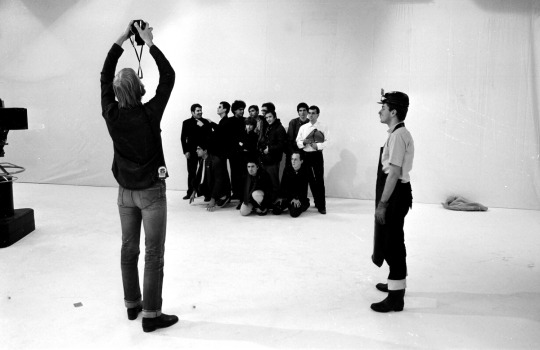
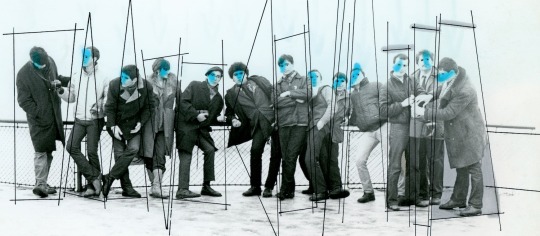
Branko Gavrić snima članove grupa Idoli, Šarlo akrobata i Električni orgazam za omot albuma Paket aranžman. Fotografije: Goran Vejvoda, 1981.
55 notes
·
View notes
Text
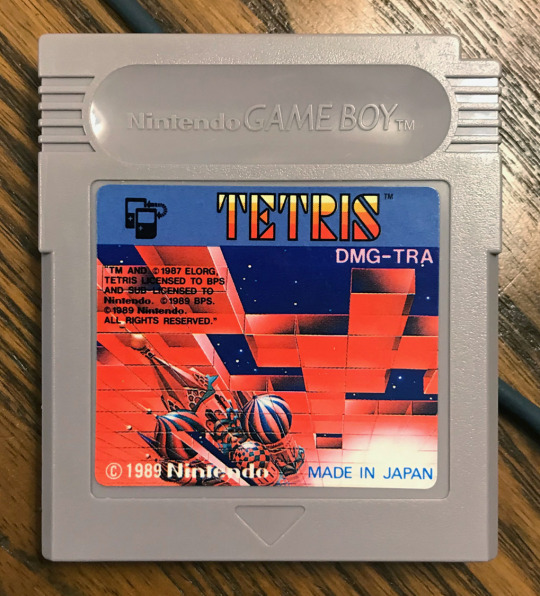
Just arrived in the mail today – a Japanese Tetris cartridge.
In pretty darn good condition for something 30 years old. Some traces of marker on the back, but I can swap that out.
Not the 'minuet' version, BTW.
I think I do prefer the US (export?) label art.
#tetris#gameboy#dmg-tra#nintendo#elorg#videogames#80s#game boy#dmg#videogame#bulletproofsoftware#1989
5 notes
·
View notes
Text
Backblog #8 - Tetris (Various)

If ever there were a game in no need of introduction, it's the game I played this time: Tetris. But I'll give one anyway. Tetris is a falling block puzzle game, originally developed by Alexey Pajitnov for the Electronika 60 computer on June 6, 1984 in the then Soviet Union. Afterward it quickly became one of the most widely ported and best-selling games of all time. It has been ported to many different computers, arcade machines, consoles, cell phones, calculators, mp3 players, PDAs, and pretty much anything else with a screen, by innumerable companies, often illegally! Especially before 1996, when the rights finally reverted back to Pajitnov from the state and he was able to co-found The Tetris Company and start bringing the hammer down.
The original version (seen above) was programmed for the Russian Electronika 60 terminal computer by Pajitnov while working at the Computer Center in the Soviet Academy of Sciences in Moscow in order to test the capabilities of the new hardware, which he often did by creating computer games. It was an extremely simple version graphically owing to the fact that the Electronika 60 had no graphical capabilities. Everything was represented in text, with the tetrominoes being represented by square brackets.
The gameplay was based on pentomino puzzles, though using tetrominoes instead for the sake of simplicity, with the pieces falling into the playfield to be arranged by the player. Originally it seems that at some point the game would’ve been just about trying to arrange the shapes and that’s it, similarly to the pentomino puzzles. But Pajitnov soon realized that the shapes filled the screen very quickly and elected to have rows disappear, thus forming the central gameplay tenet of Tetris: the objective is to make horizontal lines for as long as possible before the shapes fill up the screen.
It’s an extremely simple, yet deceptively fun and addictive formula. This goes without saying. So much so that it lends its name to a well known psychological phenomenon: the Tetris effect, in which performing a task for a long time can lead to seeing its patterns everywhere, even when just closing one’s eyes. It’s probably something you’ve experienced before, if not from actually playing Tetris, then from doing a new job or activity for the first time.
In addition to being famous for how successful and well-loved a game it is, Tetris is also infamous for its complex legal history. This is mostly due to shady practices of early companies involved but also somewhat complicated by the major stakeholder in the property for over a decade being the Soviet Union itself. In fact, for a long time, because intellectual property rights did not really exist in Soviet Russia, Pajitnov received very little money for his tremendously successful invention.
But because the history of the game is such a clusterfuck and there are so many versions of it, I figured a good way to talk about this would be to play several of them.
AcademySoft version (MS-DOS)

The original was ported to MS-DOS based IBM PC compatible computers sometime in 1986 by Pajitnov’s friend and colleague: Vadim Gerasimov, a much younger man (only 16 at the time!) who was well known within the Academy for being a computer genius. It was “published” by AcademySoft, the licensing arm of the Academy of Sciences at which they worked, in 1986. This first port was the first version I actually played and is also the version that really started to set things on fire. It was shared, originally by the programmers themselves within the offices, on disks and BBSes until it had spread all over Moscow and then Russia and eventually all over Europe.
Despite this, it’s a very hard version to go back to after having played any other version. It has graphics, sure, but the pieces consist of simple solid colors with no division between the individual blocks. The title screen logo is rendered similarly, flashing between the different colors. And everything else other than that is still rendered in text.
Of course, since it’s Tetris this wouldn’t be a huge deal if the controls weren’t so unresponsive. The controls are mapped to the number pad, which is fine (unless you have a tenkeyless keyboard, I guess), but it has what seems to be an input queue. If you hold down a directional key to try and move a piece around very quickly, it will queue up all of those inputs and continue executing them after you let go of the key. Sometimes they’ll continue even after the piece lands, so that the next piece comes out flying to the left or right without you pressing anything.
It’s possible this is a quirk of the specific version’s delayed auto shift programming or of the DOSbox emulation (though I didn’t have this problem with the next port I played on DOS). In any case, this can be mitigated by moving the pieces through individual keypresses, which is a better practice anyway. Although, it still felt like some of my inputs got lost even while doing that.
Other nuances of this version are that it has a piece rotation system that resembles the later Nintendo one (and is presumably identical to the Electronika 60′s roatation system). This means no wall kick if you rotate a piece next to a wall and no lock delay. It has hard drops only, though it is apparently possible to maneuver pieces during the drop. All of this and the controls combine to make it a pretty difficult version to play. It also requires you to press the 1 key in order to show the next piece, which is just strange. Maybe a performance related thing for computers back then? I have no idea.
The game also has no music and the only sound effects are little beeps when you clear a line or get game over. Suffice to say I didn’t play this version very long. I just played enough to fill the high score table (another new feature of this version over the original) with some pretty lousy scores, some of which were me making an early mistake and just giving up anyway.
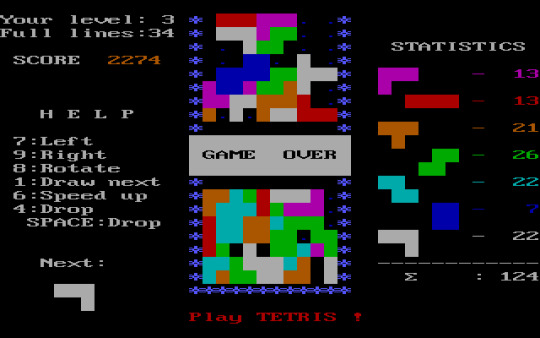
Mirrorsoft/Spectrum HoloByte version (MS-DOS)

Here is where things get interesting and legally sketchy. Sometime after the AcademySoft version set Europe on fire, Robert Stein of Andromeda Software encountered the game at the SZKI Institute of Computer Science in Budapest, Hungary along with some clones for the Apple II and Commodore 64 created by some of the students. After playing the game, he was immediately interested and was referred by them to the Soviet Academy of Sciences from where they had originally received the game.
When Stein wired a message to them displaying his interest, it was originally Pajitnov that was tasked with negotiating. However, due to Pajitnov having difficulty responding to the telex and the general Soviet disinterest in actually marketing something, Stein did not receive a reply for weeks. However, unbeknownst to the Soviets, Stein had already sold the rights to a British software company known as Mirrorsoft headed by Robert Maxwell along with its American affiliate, Spectrum HoloByte.
Despite not yet being successful with negotiating the rights from the Academy, Stein assured Mirrorsoft that the rights to the computer versions of the game were in their hands. Mirrorsoft developed and (along with Spectrum HoloByte) published a version that was widely ported throughout 1987 and 1988 to a variety of the many computers used in the United Kingdom such as the Commodore 64, Amstrad CPC, ZX Spectrum, Commodore Amiga, Atari ST, and of course the MS-DOS based IBM PC compatible, which is again the version I played.
Despite being British-developed, this version oozes Russian flair, due to Mirrorsoft wanting to play up the foreign, second-world mystique. The graphics on the title screen are almost entirely red. After a certain point the title itself changes to being the phrase “Play Tetris!” written in Russian with Cyrillic characters (pictured above). The title screen graphic itself depicts St. Basil’s Cathedral, prominently displaying its iconic onion domes. It also depicts a Cessna plane flying across (pulling a “Play Tetris!” banner), referencing an infamous incident in which a West German pilot, Mathias Rust, illegally landed a Cessna in the middle of Red Square, right in front of the Kremlin.
The difficulty selection screen depicts a map of the Soviet Union, again red. And within the game itself, as the difficulty level rises, the background image cycles through various Russian scenes, such as Yuri Gagarin’s (and humanity’s) first space flight, many of which look very cool. The background for level 5 in particular, which shows a Russian space station (pictured below), looks great. Even the packaging was red and depicted Soviet imagery, with the Cyrillic C constituting the title’s last character resembling a hammer and sickle. It all very much works in the game’s favor and gives it a lot of identity.
The controls of this game are also a lot better. You can use the arrow keys (with the Enter key to rotate) or the number pad. The controls are much more responsive without the strange input queue issue the previous one had. It has a similar rotation system to the previous version (though very slightly different) and once again only has hard drops. It still requires a press of the 1 key to display the next piece for whatever reason. It also contains a height option which generates garbage blocks up to a certain height for you to deal with, similar to Game B in the later Nintendo version. Overall it plays much better and has much better presentation.
The only shame is that it still lacks music and still only has minimal sound effects. This is true of all of the Mirrorsoft and Spectrum HoloByte computer ports, with the sole exception being the Commodore 64 version. The music is the only notable thing about that version, other than that it’s supposed to be a pretty bad version. But man, what a song it is. Clocking in at an insane near 26 minute length, it’s a very interesting song. It just doesn’t sound very Tetris-y. More like a weird psychedelic journey into the mind. But maybe I’m just biased toward the more well-known Russian tunes. Either way, C64 composers are from another dimension, I swear.
After the runaway success of this game in computer stores across both Europe and the United States, the positive press reached the Academy. The Soviets were very upset that the game had been marketed without their approval. Elektronorgtechnica (or Elorg for short), a newly created Soviet ministry handling the import and export of computer products, took over the negotiations from Pajitnov. Eventually, they did settle on granting Stein the rights to computer versions of Tetris. Despite initially being published on bogus rights, the Mirrorsoft and Spectrum Holobyte versions were now tenuously legal.
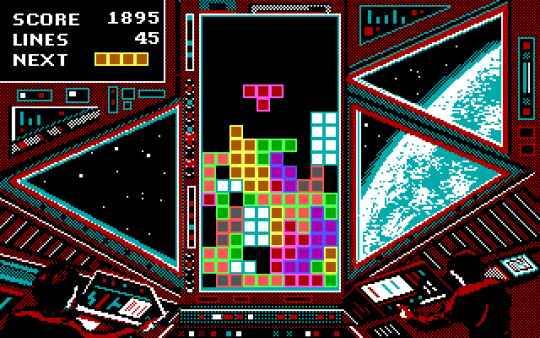
Bullet-Proof Software version (NES)

However, the situation didn’t remain legally sound for long. Though he had only received rights to the computer versions, Stein, of course, wanted a cut of the arcade, console, and handheld pie. He sent a memo back to Mirrorsoft (falsely or perhaps mistakenly) stating that he had secured the console rights and later assuring them that rights to the arcade versions would be coming shortly. In fact, despite this, Elorg was proving to be a very tough negotiator, maintaining that Stein already owed them a lot of money for the computer versions he sold without their permission.
Again, while Stein was struggling with Elorg, Mirrorsoft sold off the console and arcade rights to Atari. Atari began work on an arcade version for market in the United States, as well as an infamous NES port of this version which will be discussed later. Meanwhile, they sold the rights to a version for Japanese arcade markets to Sega, a port of which will also be discussed later. A third player also entered the fray: Henk Rogers, the president of Bullet-Proof Software, who marketed games in Japan.
Having seen one of the computer versions at a trade show, Rogers approached Spectrum HoloByte to attempt to purchase the rights for Japanese computers and arcades. After some struggling between the multiple companies, Rogers was granted the rights to the Japanese computer versions but was informed that the Japanese arcade rights had already been sub-licensed to Sega and was told if he wanted to purchase other Japanese rights, he would have to sub-license them from Atari.
After meeting with them he was able to secure rights to market the game in Japan for the Famicom, while Atari still intended to sell their version in the United States. The game was now split among at least five different companies across multiple markets for multiple platforms. Bullet-Proof Software developed and published its Famicom version (the next version I played) in Japan on December 22, 1988 along with versions for a number of different Japanese PCs including the NEC PC-88 and PC-98, the Sharp X1 and X68000, and the Fujitsu FM-7. With their computer, console, and (through Sega) arcade markets filled, the Tetris craze could now thoroughly sweep Japan.
This version is the first console version I played and is pretty much where things start to get very good. Visually, it also retains the Russian feel that the Mirrorsoft and Spectrum HoloByte computer versions had, but doesn’t present it quite as strongly. Its title screen image, also of St. Basil’s Cathedral, is somehow less visually interesting despite having more than two colors and integrating the tetrominoes into the image (I guess implying that you’re building the cathedral in the gameplay?). It also only has one background during the gameplay depicting a couple of onion domes.
One enormous leg up it has presentation-wise though is the fact that it has music and a wider variety of sound effects. The title screen music marks the first appearance of the Russian folk song “Korobeiniki“ (often known as the Tetris theme) in a Tetris game. The in-game music includes two other Russian folk songs, “Kalinka” (or Karinka as the in-game Engrish refers to it) and “Troika”, both of which are also featured in Atari’s version. The third song featured is an original one, “Technotris”, which actually slaps pretty hard. The only drawback is the games run pretty long in this version, so any of the songs can get old quickly.
The reason the games run longer in this version is that it is structured very differently from the marathon style of the other versions so far. In addition to just being difficulty levels, the levels in this version are also literally that. After clearing a set number of lines, the level completes and it is only then that you are awarded your score. After the end-of-level scoring display disappears, so too do all the pieces remaining on the field, giving you a fresh slate to work with, at least for the first round of levels. It also features a lives system, allowing you fail multiple times before a game over. This ends up making the game feel too easy, at least at first.
Another thing about the game that is immediately noticeable is that drop (of which there is again hard drop only) is mapped to the A button, while rotate is mapped to down. For me at least, this feels completely backward, but you do get used to it. Some further nuances of the game are that it used its own rotation system, but this system served as a the predecessor for the Standard Rotation System that would eventually be put in place as The Tetris Company much later tried to standardize the look and feel of the numerous Tetris ports.
In fact, this game is a common lineage for many later Tetris versions, owing to the fact that Bullet-Proof Software was, in the end, one of the few companies to hold on to publishing rights. Henk Rogers eventually helped Pajitnov found The Tetris Company, essentially making Bullet-Proof Software (later Blue Planet Software) comprise 50% of that company.
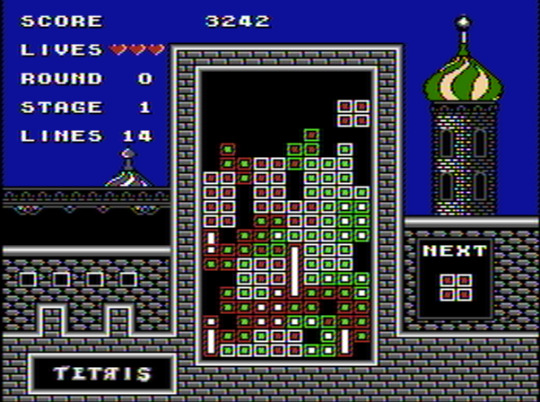
Sega version (Genesis)

As mentioned above, Sega received the rights to create a version for Japanese arcade markets from Atari. This was after a Sega of America employee discovered one of the many versions of the game. Although these were rights that Elorg had not given away originally, they would eventually be granted to Stein, causing the rights chain that went to this version to be retroactively legal.
Whatever the case, Sega’s arcade version did very well in Japan, releasing in December 1988. As opposed to the Bullet-Proof Software version, it helped to popularize the marathon style of play instead of the level-based style. Its Sega Rotation System and other rules became the prototype for many other different versions of Tetris, including the popular Tetris: The Grand Master series.
But specifically, I would like to talk about the version I played, the ill-fated Genesis/Mega Drive port, developed by Sanritsu and intended to have been released sometime in 1989. Though a prototype exists (and at one point a copy of it was put on auction for a million dollars, due to its extreme rarity), it was shelved due to the copyright issues that would eventually come to a head over the legality of the console versions of the game. Although, strangely, this version did get a release in the form of Sega’s Mega-Tech hardware based on the Genesis/Mega Drive due to it technically being an arcade game.
Though it is a very faithful recreation of the arcade game, presentation-wise it seems kind of boring. The title screen consists of a logo written into bricks set over a bland blue-green landscape that seems to have had tetris pieces pulled out of it. Like the Mirrorsoft/Spectrum HoloByte versions, the background of the playfield changes as you play (though in this version it’s based on getting tetrises rather than the level rising). This game, rather than Russian scenes, depicts scenes from prehistory and human history: from an ocean landscape, to dinosaurs, to the Ice Age, to Stonehenge, to more modern buildings and cities, and finally to a futuristic city.
Aside from looking kind of boring, with their look resembling digitized photographs (even though they obiously aren’t, considering the futuristic city and tripod-posture tyrannosaurus), the images are mostly blocked by the playfield. I didn’t even know the fourth background had a dinosaur until I paused the game. The arcade version does have a monkey that animates throughout play so that’s one advantage it has, I guess.
The song that you hear for most of the play, “Tetremix”, is also somewhat boring. It’s a very low-tempo, bassy song (though as you advance through the levels it increases in tempo until it reaches kind of a mid-tempo but that’s it really). There is a second song that plays when you get dangerously close to the top, along with title screen and ranking entry songs, but none of them are really worth writing home about.
But despite all this, the gameplay in this version does hold up. It’s the first version I played that has both hard and soft drops. As mentioned before, it has a precursor to the rotation system seen in the Tetris: The Grand Master series although, strangely, the ceiling also blocks rotation, which took some getting used to. The scoring system complements the marathon gameplay very well, giving bigger score bonuses the higher a piece lands and therefore encouraging the player to take bigger risks beyond just trying to get a clean and at least four high row stack for a tetris.
The biggest addition to this version, however, are the special item blocks that can be toggled on or off before each game. If turned on, every ten pieces, a flashing tetronimo will come down. Depending on which shape it is, it can activate different effects upon being used to clear at least one line. These effects can include a larger score bonus, raising or lowering the level, or clearing three other nearby lines.
Overall, I didn’t care for this version very much. I certainly don’t think it’s worth the million dollars. But I do appreciate what it’s gameplay brought to the table as well as its status as the progenitor of the Tetris: The Grand Master series. On a more positive note, this version actually did eventually receive a home console port in Japan as part of the Sega Ages 2500 Series Vol. 28: Tetris Collection for the PS2. This compilation included the original arcade game along with two Tetris-like sequels made by Sega: Flash Point and Bloxeed. It also included a new version called Tetris: New Century.

Nintendo version (NES)
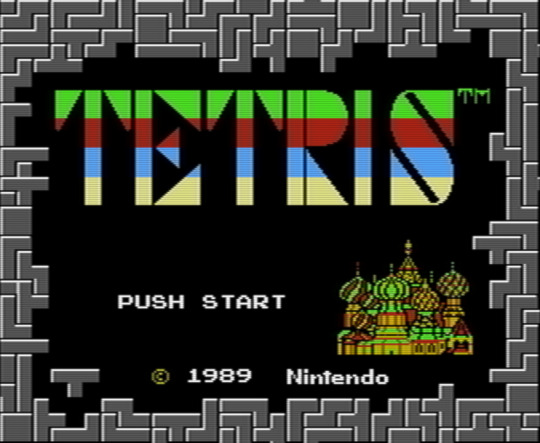
Here is one of the versions that everybody knows, along with the Game Boy version. And these versions only materialized after the rights tensions came to a head in the form of a vicious legal battle between Nintendo and Atari over the console rights to the game. It began after Nintendo was finalizing their design for the Game Boy and decided they wanted to have Tetris as a pack-in game. They enlisted the help of Henk Rogers, who they had a positive business relationship with, and who recognized the potential of the Game Boy prototype of the game they showed him.
Rogers began to attempt correspondence with Stein to let him know they should try to secure handheld rights as soon as possible but essentially got the cold shoulder from him. Stein was in fact still struggling to make deals with the Soviets on his end. Eventually, Rogers lost his patience and flew to Moscow to secure the rights himself. Coincidentally and unbeknownst to one another, both Stein and Robert Maxwell’s son, Kevin Maxwell, also ended up flying to Moscow, frustrated with the way the negotiations were going.
Rogers was the first to meet with Elorg at the Academy. He managed to quickly make a good impression on them, especially Pajitnov himself who he ended up befriending. With this, he was able to easily secure the handheld rights to the game and signed a contract after only two meetings. In a cheerful mood after his successful deal, he decided to show them a copy of his Famicom Tetris that he had brought along. The mood of the room immediately fell off a cliff as the Soviets asked what the game was. After Rogers explained what it was, they angrily declared they had never sold the console rights.
As Rogers tried to frantically explain how he secured that deal and from whom, he realized that the rights he bought were a sham. Meanwhile, the Soviets also found out from him that Atari was marketing and sub-licensing arcade rights. Rights which they also never gave away. Rogers, wanting to make things right and stay within his benefactors good graces to maintain the deal he just made, agreed to pay them back-royalties for all of the Famicom carts that had sold, including a large advance. Appeasing them, Rogers realized this was also his chance to secure the console rights for Nintendo. While Mirrorsoft and Atari were both big contenders, Nintendo was the proverbial 800-pound-gorilla in the room at the time for video games and had very deep pockets.
Sometime later, Stein met with Elorg. Rather than discussing the arcade and handheld rights, they immediately make him sign an addendum to his computer rights contract. Focusing on the parts of the addendum concerned with the late fees he owed, he did not pay much mind to the seemingly innocuous line that very clearly defined what a computer is. This was part of the plan to prevent him from arguing that he did own the console rights as part of the computer rights. After he eventually decided to sign it, Elorg gave him the arcade rights (which he still had to pay a very large amount of money for), but not the handheld rights.
When Maxwell ended up meeting the Elorg representatives, they simply presented him with the Famicom cart, asking what it was. Maxwell, not knowing that his own company had sold the console rights to Tetris, maintained that it must be a pirated copy. This gave Elorg further ground upon which to claim that Mirrorsoft, and by extension Atari, had no right to the console versions of Tetris. Impressively, within these three meetings, the Soviets had regained complete control of the situation.
As Elorg worked with Rogers as well as officials from Nintendo of America, including Howard Lincoln and Minoru Arakawa, on the case, Lincoln sent a cease-and-desist to Atari, ordering them to stop production of their NES game. The tensions escalated to the point that the senior Maxwell of Mirrorsoft’s parent company started throwing his weight around, even using his significant ties to convince the President of the Soviet Union, Mikhail Gorbachev, to put pressure on Elorg.
Eventually, once the Nintendo v. Atari trial actually started, it all came down to whether or not the NES and Famicom could be considered computers. Atari argued that it was, pointing to its extension ports, networking capabilities, and even the fact that Famicom is short for “Family Computer.” Nintendo’s argument was more straightforward. The Academy only ever intended to sell the rights to computer versions as explicitly defined in the contract. The court eventually ruled in favor of Nintendo, who were then able to legally make Game Boy and NES versions of the game.
With that extremely long preamble out of the way, Nintendo was able to make a Game Boy version of Tetris in June of 1989, which became a pack-in. They followed up with the NES version (which is the version I played) which was developed and published by Nintendo in November of 1989. With this, the Tetris craze was able to sweep the United States more thoroughly than ever before. Because the Game Boy version led to sales of Game Boys and more Game Boy games, it was an incredible success for Nintendo.
While I still think the title screen for the Mirrorsoft/Spectrum HoloByte version has the cooler looking rendition of St. Basil’s Cathedral, this one looks pretty slick overall. The logo and the border around the title screen look very good. There aren’t any changing backgrounds in this version, which is a shame, but instead the pieces change colors as you advance through the levels which keeps things visually interesting.
Like the Bullet-Proof Software and Atari versions, this one has music with Russian folk flavor. Music 1 is “Dance of the Sugar Plum Fairy” from Pyotr Tchaikovsky’s ballet, The Nutcracker. Music 2 is an original composition, but still retains the Russian sound. Music 3 is another original, but is also recognizable as the song that played when Nintendo put you on hold at the time. Of these, I typically go with Music 1 most often. Also, the victory music for Game B is the “Toreador Song” from Georges Bizet‘s opera, Carmen. Unfortunately, it does not contain “Korobeiniki“ like the Game Boy version does.
Gameplay-wise this version uses the Nintendo Rotation System and lacks a hard drop, but does use soft drop. It also has a Game B which plays similarly to games using the height option from the Mirrorsoft/Spectrum HoloByte version. It spawns garbage blocks up to a specified height and challenges you to clear a certain number of lines. Depending on the height and difficulty you select, you get different victory screens, with the hardest ones showing several Nintendo characters. Game A also has a victory screen if you get a high enough score, showing a rocket being launched.
With its solid gameplay and presentation, this ended up being the version that I played the longest. I even ended up getting some halfway not terrible scores. It also helped that the Retro Achievements site that I used actually had some cheevos for this game that did a good job of encouraging me to shoot for better scores. The only real drawback to this version is it lacks the multiplayer modes seen in the Game Boy version, but these modes were added to the port of this version included in Tetris & Dr. Mario, so it’s not a total wash. Overall, this is probably among the best of the early Tetris versions.
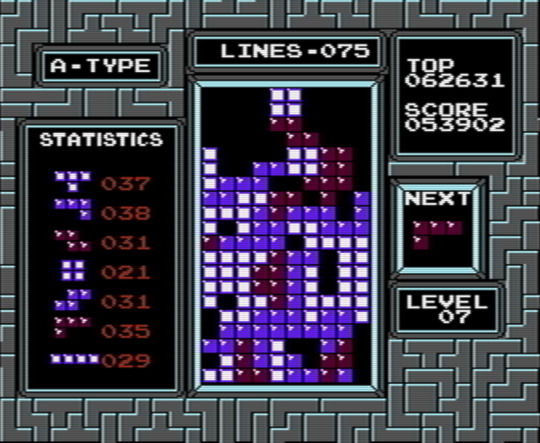
Tengen version (NES)

So, this is the version that got the short end of the stick. Even more than the Sega Genesis version. Even though this version did actually release (despite the cease-and-desist from Nintendo), after the lawsuit Atari was forced to take it off shelves pending the verdict which was ultimately a loss for them. This led to hundreds of thousands of copies of the game that they produced but could not sell and were forced to leave to languish in a warehouse. This was a huge financial loss for them. It also led to the game being somewhat of a collector’s item, but the copies don’t sell for the extreme amounts the Genesis version does, since there were a lot of copies sold prior to the lawsuit.
Atari’s arcade port was released sometime in 1988 and this port was developed by Atari and published by Tengen in May of 1989. Tengen was Atari’s console games division and even beyond Tetris was infamous for the legal trouble they were often in. Prior to the Tetris lawsuit, they landed in hot water for bypassing Nintendo’s lock-out chip on the NES in order to publish unlicensed games, since Nintendo only gave publishers license to create three games a year.
And y’know, it’s really a shame that this game got recalled because it’s actually pretty damn good. The title screen features the usual cathedral, in a large and colorful rendering with fireworks being set off. It also features a nice looking border. While it doesn’t go quite as ham as the computer versions, there is one piece of faux-Cyrillic in the logo with the backwards R. The graphics on the playfield look pretty basic though and I don’t really care for the way the pieces look.
This version includes one more song than either the Bullet-Proof Software or Nintendo versions. Two of them are original compositions, “Loginska” and “Bradinsky”, named after one of the programmers and the composer respectively. Both songs still manage to retain some Russian flavor. The other two songs are “Kalinka” (still in Engrish in-game despite being done by a western company) and “Troika” which both appeared in the Bullet-Proof Software version. Of these, my favorite is probably “Kalinka.” Also included is the traditional Russian song “Katyusha,“ which plays during the scoring screen in between levels.
The gameplay uses its own Atari Rotation System with soft drop only. Like the Bullet-Proof Software version, the gameplay is level-based, though you still accumulate points during the actual levels, unlike that version. After clearing a set number of lines, a score screen comes up which calculates bonuses depending on how many singles, doubles, and so on you scored. Also, unlike the Bullet-Proof Software version, the pieces are not cleared from the screen after completing a level. There is also a handicap option which is really just the height option seen in the other versions. The difference here is that the blocks spawned with the handicap are more tightly packed, making it easier to clear them right away. Unfortunately, it seems as though some of the later level challenges such as randomly spawning garbage blocks present in the Atari arcade version were cut.
The really nice thing in this version however is the multiplayer modes. Had these modes not been cut, these would’ve been a deciding factor in whether or not to purchase this over the Nintendo version. It features competitive multiplayer against another player or against the computer. Also, strangely, it features cooperative play with another player or the computer. The co-op mode features a very large playfield with two pieces falling at once, one controlled by each player. It’s a strange mode, but it’s so interesting that I’m glad they included it. It seems like something that can create a lot of friction between people trying to play it as they accidentally fuck each other over.
Overall, this is actually a great version. A lot of people at the time of its rocky release and recall argued that it was the better version. While I do love the Nintendo version, it’s really a tough call. If it had the little challenges present in the later levels of the arcade version and the multiplayer modes, I would definitely agree.
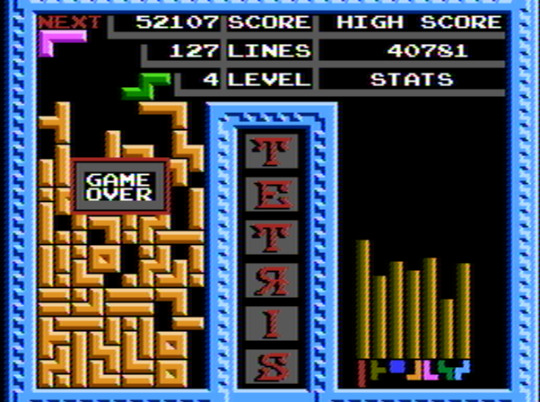
In the end, Nintendo’s versions of the game definitely came out on top legally. The Tengen versions were recalled, being a big hit against Atari. Mirrorsoft collapsed during the legal struggle, although Spectrum HoloByte managed to survive and make a couple of Tetris sequels for computers along with Pajitnov. Robert Stein made relatively little off the game, but probably could’ve made more had the companies he sub-licensed to (legally or not) paid him royalties.
The big winner other than Nintendo was Henk Rogers of Bullet-Proof Software. His company managed to continue making Tetris sequels and variants. Eventually, after the rights to the original game reverted from the Soviet Union to Pajitnov, he and Rogers worked together to form The Tetris Company. Together they continued the Tetris legal battles, working to remove many of the other versions of the game that had cropped up illegally and also worked to standardize the formula for legally licensed versions.
So, that’s a very brief history of Tetris’s tumultuous early releases, along with my thoughts on some of those versions. A lot of the material in this, my longest entry yet, is sourced from David Sheff’s Game Over, a book on the business history of Nintendo, which includes a couple of chapters about Tetris. It’s an extremely interesting story and I obviously couldn’t include the level of detail present in this book, so it’s definitely a recommended read. Next time, I’ll be continuing my puzzle game gauntlet with some of the early Tetris sequels, starting with Welltris. Until then, take it easy~

Image Sources:
Electronika 60 screenshot - Tetris Wiki
The rest are screenshots taken by me
#text post#backblog#backlog#backloggery#video games#tetris#academysoft#elektronorgtechnica#elorg#mirrorsoft#spectrum holobyte#bullet-proof software#sega#sanritsu#nintendo#atari#tengen#alexey pajitnov#vadim gerasimov#robert stein#henk rogers#pc#ms-dos#nintendo entertainment system#famicom#sega genesis#sega mega drive#puzzle#falling block
3 notes
·
View notes
Photo

Kreativnost, pobuna, sloboda, urbani duh, sve to bilo je rezervisano za novi talas – muzički pravac koji je dobio kultni status u jugoslovenskoj istoriji muzike i kulture i možda se sa pravom naziva „poslednjim snom Jugoslavije“.
Pred čitaocima je nova knjiga Dušana Vesića „Bunt dece socijalizma“ o prvoj generaciji bendova novog talasa (Azra, Električni orgazam, Film, Haustor, Idoli, Lačni Franz, Paket aranžman, Pankrti, Paraf, Parlament, Pekinška patka, Piloti, Prljavo kazalište, Šarlo Akrobata, Termiti), kojom autor zaokružuje trilogiju o najvažnijim momentima jugoslovenske rok kulture. Ovo je i prva sistematska, detaljna priča o ovom periodu, neumoljiva hronika pisana karakterističnim Vesićevim stilom koji Branimir Štulić poredi sa borhesovskim, uz obilje zanimljivih i manje poznatih podataka.
U isto vreme neposredni posmatrač koji je iz blizine pratio novi talas tokom njegovog nastanka, vrhunca i gašenja, Vesić je ujedno i pažljivi i odmereni hroničar koji s vremenske, ali ne i emotivne distance dočarava, oživljava i približava kulturnu epohu precizno i živopisno.
Onima pak koji to vreme ne pamte ova knjiga će u nekoliko poteza pera pokazati zašto se o tom periodu govori i neverovatnih četrdeset godina kasnije. Novi talas? Kao da je bio juče!
Knjigu prate i ekskluzivne fotografije.
„Bunt dece socijalizma“ možete pronaći od sreda 10. juna u svim knjižarama Delfi, Laguninim klubovima čitalaca, onlajn knjižari www.delfi.rs i na sajtu www.laguna.rs.
#knjige#novo#promocija#knjizevnost#pobuna#bunt#omladina#jugoslavija#socijalizam#deca#bendovi#rokenrol#azra#pankrti#film#idoli#haustor#elorg#prljavo kazaliste#hronika#dusan vesic#laguna#delfi knjizare#mediji#laguna knjige
0 notes
Photo
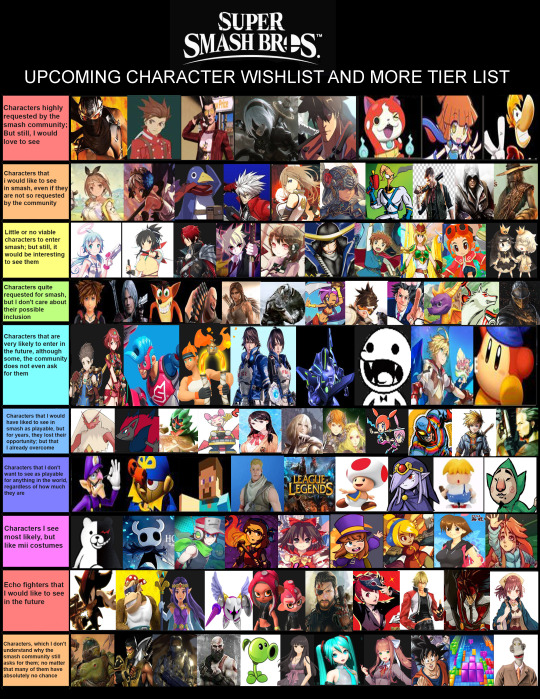
super smash bros chars wishlist and random tier
here the listed chars
tier #1
Ryu Hayabusa (Ninja Gaiden) [Koei Tecmo]
Lloyd Irving (Tales Of Series) [Bandai Namco]
Travis Touchdown (No More Heroes) [Marvelous]
YorHa #2 Type B aka 2B (NieR/Drakengard Series) [Square Enix]
Sol Badguy (Guilty Gear) [Arc System Works]
Jibanyan (Yo-kai Watch) [Level-5]
Arle Nadja (Puyo Puyo) [Sega]
Rayman [Ubisoft]
Tier #2
Reisalin Stout aka Ryza (Atelier Series) [Koei Tecmo]
Gwendolyn (Odin Sphere Leiftrasir) [Atlus]
Prinny (Disgaea Series) [Nippon Ichi Software]
Ragna The Bloodedge (Blazblue) [Arc System Works]
Alisa Ilichina Amiela (God Eater) [Bandai Namco]
Lenneth (Valkyrie Profile) [Square Enix]
Earthworm Jim [Atari]
Booker Dewitt (Bioshock Series) [2K Games]
Ezio Auditore (Assassin's Creed) [Ubisoft]
The Stranger (Oddworld Stranger's Wrath) [Oddworld Innabitants]
tier #3
Ekoro (Gal*Gun) [Inti Creates]
Asuka (Senran Kagura) [Marvelous]
Adol Christin (Ys Series) [Falcom]
Hyde Kido (Under Night In-Birth) [Arc System Works]
Madotsuki (Yume Nikki)
Masamune Date (Sengoku Basara) [Capcom]
Oliver (Ni No Kuni) [Level-5]
Valkyrie (The Legend Of Valkyrie) [Bandai Namco]
Parin (Gurumin) [Falcom]
The Liar Princess And The Blind Prince [Nippon Icchi Software]
tier #4
Sora (Kingdom Hearts) [Square Enix]
Dante (Devil May Cry) [Capcom]
Crash Bandicoot [Activision]
Heavy (Team Fortress) [Valve]
Lara Croft (Tomb Raider) [Square Enix]
Dovakiin (The Elder Scrolls Series) [Bethesda]
Shantae [Wayfoward]
Tracer (Overwatch) [Blizzard]
Phoenix Wright (Ace Atourney Series) [Capcom]
Spyro The Dragon [Activision]
Amaterasu (Okami) [Capcom]
Chosen Undead (Dark Souls) [From Software]
tier #5 [All from Nintendo]
Rex and Pyra (Xenoblade Series)
Springman (ARMS)
Ring Fit Trainee (Ring Fit Adventure)
Akira Howard (Astral Chain)
Sylux (Metroid Series)
Marshall (Rhythim Heaven/Paradise)
Euden (Dragalia Lost)
Bandanna Dee (Kirby Series)
tier #6 [All from Nintendo]
Blaziken (Pokemon Gen 3)
Zoroark (Pokemon Gen 5)
Decidueye (Pokemon Gen 7)
Jill (Drill Dozer)
Tsubasa Oribe (Tokyo Mirage Sessions)
Aeron (Pandora's Tower)
Frey and Freya (Zangeki No Regileiv)
Kat and Anna (Wario Ware series)
Captain Rainbow
Isaac (Golden Sun)
Raymond Bryce (Disaster: Day Of Crisis)
tier #7
Waluigi
Geno
Steve (Minecraft) [Mojang]
Jonesy (Fornite) [Epic Games]
Any char from League Of Legends [Tencent]
Toad
Vaati (Legend Of Zelda)
Porky Minch (Mother/Earthbound)
Tingle (Legend Of Zelda)
tier #8
Monokuma (Danganrompa) [Spike Chunsoft]
Hollow Knight [Team Cherry]
Quote (Cave Story) [Nicalis]
Cadence (Crypt Of The Necrodancer) [Spike Chunsoft]
Reimu Hakurei (Touhou)
Hat Kid (A Hat In Time)
Robin (Iconoclasts)
Umihara Kawase [Nicalis]
Madelyn (Celeste)
tier #9
Shadow the Hedgehog, as Sonic's EF (Sonic series) [Sega]
Funky Kong, as DK's EF (Donkey Kong Series)
Hilda, as Zelda's EF (Legend Of Zelda)
Galacta Knight, as Meta Knight's EF (Kirby Series)
Octolings, as Inklings' EF (Splatoon)
Big Boss aka Venom Snake, as Snake's EF (Metal Gear Solid) [Konami]
Kasumi aka Violet, as Joker's EF (Persona series) [Atlus]
Rock Howard, as Terry's EF (Fatal Fury) [SNK]
Order Sol, as Sol's EF; once he enter to smash (Guilty Gear) [Arc System Works]
Sophie Neuemuller, as Ryza's EF; once she enter to smash (Atelier Series) [Koei Tecmo]
tier #10
Doomslayer aka Doom Guy (Doom Series) [Bethesda]
Scorpion (Mortal Kombat) [WB Games]
Master Chief (Halo) [Microsoft Studios]
Kratos (God Of War) [Sony IE]
Pea Shooter (Plants VS Zombies) [EA]
Chiaki Kurokawa (The Idolmaster)
Hatsune Miku (Vocaloid) [Crypton Media]
Monika (Doki Doki Literature Club)
Goku (Dragon Ball Series) [Shueshia]
Tetramino (Tetris) [Elorg]
Tulio Trivino (31 Minutos) [APAPLAC]
#super smash bros#super smash ultimate#super smash bros ultimate#Smash Bros#tier list#wishlist#nintendo#sora#sakurai#atlus#arc system works#koei tecmo#capcom#bandai namco#square enix#activision#blizzard#bethesda#valve#2k games#ubisoft#spike chunsoft#marvelous
58 notes
·
View notes
Text
Friday Special #3
November 13th, 2020
Welcome to today’s Friday Special!
For this week, we’ll be digging into some history of a country, a company, and how a little game called Tetris changed the international gaming landscape.

Okay so imagine this
The year is 1984.
In America, Van Halen had released their iconic album 1984 to the masses. Apple Macintosh introduced their first personal computer. The XXIII Olympiad is held in Los Angeles, California. The space shuttle Discovery makes its maiden voyage into space.
In Japan, Nausicaä of the Valley of the Wind hits theatres and would put Hayao Miyazaki into the spotlight, encouraging him and others to create Studio Ghibli the following year. NHK, the national broadcasting network, tests out a new type of satellite called the BS-2a. The Sony Discman is one of the hottest electronics to own as Compact Discs (CDs) had started to gain popularity.
What about the Soviet Union?
Besides a collision of Soviet submarine K-314 and the USS Kitty Hawk as well as the country famously boycotting the Summer Olympics that year, not much.
Wait, what about Tetris?
Buckle up.
So the insanely popular puzzle game Tetris had its simple start in the USSR and was created by Russian programmer Alexey Leonidovich Pajitnov. It was conceptualized and created during Pajitnov’s time as a speech recognition researcher at the Soviet Academy of Sciences in St. Petersburg. Pajitnov designed Tetris and similar puzzle games like it because he wanted computers to make people happy and believed that "games allow people to get to know each other better and act as revealers of things you might not normally notice, such as their way of thinking."
Tetris first saw life on the Electronika 60, a Soviet computer at the time and also a rare commodity even then, and was released on June 6, 1984. It was the result of Pajitnov trying to recall a favorite childhood game and it used the shapes of tetrominoes (geometric shapes that are connected orthogonally [at the edges, not corners] and fit like a jigsaw puzzle, Tetris calls them tetriminoes). The first version of Tetris had no score system or levels but it was popular amongst his colleagues for its addictive gameplay.
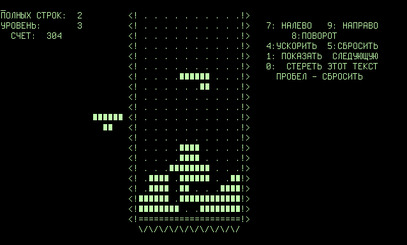
The game became so popular that Pajitnov enlisted the help of Vadim Gerasimov, a 16-year-old high school student with a knack for computer skills, to adapt the game to the IBM Personal Computer (released in 1981) and they were successfully able to do so, with Pajitnov adding color and a soundboard for the second version.
Although the Academy disliked the success that the game was getting, Pajitnov had a dream of exporting the game to the world. He got help from Victor Brjabrin to help with the publication of Tetris, where the first international copy of Tetris wound up with the Hungarian company Novotrade in 1986. The game would then be distributed all over Hungary and even reached Poland. It was in that same year and place that Robert Stein, international software salesman for the firm Andromeda Software (based in London, England) would be exposed to the popular puzzle game and he was so impressed by it that he faxed the co-creators directly for the license rights.
Here’s one thing to keep in mind, even a deal made over fax communication in the Western world is a legally-binding contract.
This is where things get hairy
Tetris would see its major American introduction in Las Vegas at the 1987 Consumer Electronics Show. After that and several negotiations, Stein gave the firm Mirrorsoft the European rights and the American rights to Spectrum Holobyte. With the rights in their grasp, Mirrorsoft released their version on the IBM PC in 1987 and Spectrum Holobyte version released in January of 1988. As a result, Tetris became an international phenomenon and became highly successful in both North America and Europe. The game itself was later ported to Amiga, Atari ST, ZX Spectrum, Commodore 64 and Amstrad CPC.
Despite the good fortune however, Stein was left with an issue. See, he sold the license of the game without actually owning it. After some more negotiating, this time with the central organization for importing/exporting of the Soviet Union Elorg (Elektronorgtechnica), the deal was made that Tetris would be made available for all current and future computer systems.
So where is Tengen in all of this?
In 1988, Tengen, a subsidiary of Atari Games, received the Japanese rights from Mirrorsoft. Tengen then sold the arcade rights to SEGA and the console version to BPS (Bullet-Proof Software). BPS would go on to create a version of Tetris for the Nintendo Famicom System (The NES in North America) in 1989.
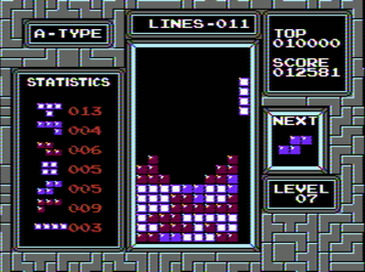
Tengen the subsidiary was founded in December of 1987 and was Atari Games’ response of needing a firm to oversee the console gaming side of the company. The only licensed games that were released under Tengen were R.B.I. Baseball, Pac-Man, and Gauntlet.
Yeah, the famous Tengen version of Tetris was actually unlicensed.
Under Tengen, Tetris went under the name Tetris: The Soviet Mind Game in May of 1989, although the arcade machine clones would read 1988.
So at this point, at least a dozen of different companies held rights to the Tetris game, with Stein in particular holding exclusive home computer rights. Nintendo would be ready to go with their introduction of the Gameboy in 1989.
AAAAAnd here’s where the problems arise.
When Henk Rogers, a Dutch video game designer and entrepreneur for Nintendo, was trying to obtain handheld console rights, he was unsuccessfully able to get in contact with Atari before trying to contact Stein. While relations were good at first, Rogers started getting suspicious that Stein had a breach of contract and traveled to the Soviet Union not only to investigate, but to contact the Elorg itself about handheld console rights.
What he ended up doing was getting involved in a meeting that contained Stein and Mirrorsoft manager Kevin Maxwell over rights with the Elorg president Nikolai Belikov present. When Belikov was shown a Tetris cartridge by Rogers, he was surprised as he believed that Tetris was only licensed for home computers. Had not Rogers defended that the rights were sold to Nintendo through Atari Games thanks to Stein, and Rogers being on good terms with Pajitnov, Nintendo would have been sued into oblivion for illegal publication of the game.
During the discussions, Belikov offered to null and void Stein’s rights to the game and instead offered Nintendo full rights to their home consoles and handheld consoles. Thanks to Rogers, Minoru Arakawa and Howard Lincoln, both Nintendo executives, signed off on the contract and Stein was left in the dust, losing all the console rights lost due to failing to read about the clause that defined the computer as “a machine with a screen and a keyboard” and not a console.
With this, Nintendo sent a cease-and-desist to Atari Games, demanding that they stop making the NES version of Tetris. However, Mirrorsoft was on Atari’s side, insisting that they still had rights. Nintendo didn’t give in on its stance however, and things got so out of hand that even the Soviet Union President Mikhail Gorbachev had to get involved on Mirrorsoft’s behalf.
Talk about pressure.
What then ensued was the legendary lawsuit between Atari Games and Nintendo, with Atari Games claiming that since the Nintendo Famicom (Nintendo Family Computer is its full name) had “computer” in the name and that it featured an extension input that can allow the console to be converted into a computer, thus it could not claim the rights as stated in the Elorg contract, since it was a classified as a computer.
(While the Famicom does have a third-party extension on the bottom right side of the console, that was usually there for third-party controllers at the time. Down below is the extension input in question.)
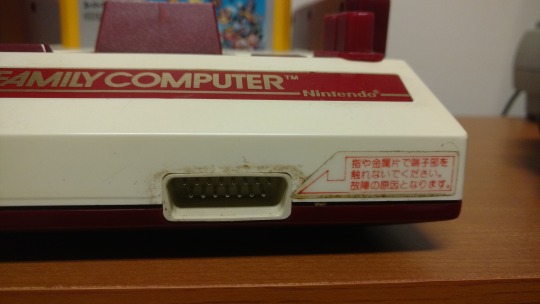
Pajitnov testifed on Nintendo’s behalf, saying that the contract only affected computers and nothing else, and Belikov, also on the side of Nintendo, argued the same stance.
Ultimately, the case was ruled in Nintendo’s favor as it was discovered that Mirrorsoft and Spectrum HoloByte never received explicit authorization for marketing on consoles. As a result, Atari Games withdrew the NES version of Tetris from the market by the hundreds of thousands.
So what about Pajitnov? Did he ever get any money out of this?
Nope.
See, because of the laws in place regarding ownership of property in the Soviet Union at the time, Pajitnov could neither patent or make money off of his product and he never received any of the royalties for Tetris, hence the existence of so many clones. Despite this, he remained optimistic, quoted saying “The fact that so many people enjoy my game is enough for me."
Don’t worry, the story does have a happy ending though.
Over the years since Tetris’ worldwide introduction, Pajitnov was routinely invited by journalists and publishers to speak and give interviews, giving him a reputation in the West. After being introduced to America for the first time in 1990 after receiving an invite to the Consumer Electronics Show in Las Vegas by Spectrum Holobyte, he began to study American culture by traveling to different cities of the United States. It was reported that he spoke of his travels often to his colleagues back in the Soviet Union. He was very proud of the game’s success and even called it “an electronic ambassador of benevolence.”
He and Vladimir Pokhilko, a friend of his, later emigrated to the West Coast of the United States in 1991 where Pajitnov settled in Seattle, Washington. He finally regained the rights to Tetris in 1996, exactly a decade as agreed by the Academy when the deal was made regarding rights, and in that same year, founded The Tetris Company to manage all rights after all other contracts had expired. It was then that he finally started making royalties for Tetris and also founded Tetris Holding after the dissolution of the Soviet Union. Tetris Holding is responsible for taking unlicensed Tetris clones off of the market.
Recently in 2005, EA purchased Jamdat, a mobile game company that Rogers founded in 2001 to manage the Tetris license. They then held a 15-year license for all mobile phone releases until April of 2020.
So there you have it, one of the most famous lawsuits in history about one of the most famous video games in history.
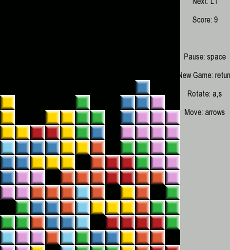
#whew!#talk about a loooooong history#hope you learned something new!#also yes that Famicom console in the third picture is actually mine#my voice!#friday special#retro gaming#gaming#irl#history#gif
13 notes
·
View notes
Photo

Happy (early) Birthday, to me! #CrashBandicoot #crashnsanetrilogy #puyopuyo #puyopuyotetris #meanbeanmachine #activision #vicariousvisions #sega #Tetris #tetrisholding #elorg #nintendoswitch #PS4 #PlayStation4 #PlayStation #Sony #naughtydog #earlybirthday #gaming #videogames
#puyopuyo#crashnsanetrilogy#nintendoswitch#earlybirthday#elorg#gaming#meanbeanmachine#crashbandicoot#puyopuyotetris#vicariousvisions#tetris#ps4#playstation#sega#activision#playstation4#tetrisholding#videogames#naughtydog#sony
0 notes
Photo

Box Brown: Tetris: The Games People Play (2016)
#box brown#tetris#2010s#games#video games#nintendo#atari#soviet union#first second books#henk rogers#Alexey Pajitnov#elorg#copyright#Robert Stein#robert maxwell#gunpei yokoi#shigeru miyamoto
0 notes
Text
Custom Clone golf Clubs - InfoBarrel
Golf is one of probably the most popular sports in the world. Over 850 million tennis balls are produced and shipped annually and generate about $550 million in annual sales. The Cobra driver has got the biggest club face of every one of the 460 cc drivers about the market. Often times lumberjacks will attack opponents as well, rendering it similar to No DQ. Not Wanted Here.
Titleist, HP Eclipse MINT is for golfers seeking extremely low driver and iron spin for long, straight, more accurate distance. A multi-layer product, the Black Label ball features an oversized solid core, an interlocking layer of polyurethane involving the core and outer cover, and a soft urethane outer cover. com/photos/elorg/.
youtube
The only statistic that sports bettors ought to be concerned with is units won, which is the amount of profit, or loss, they've over time, and not worry nearly the maximum amount of about whybest golf drivers for high handicappers winning percentage. It comfortably holds 10 to 12 discs, includes a side pocket for the favorite beverage and comes with plenty of additional pockets for miscellaneous storage. The material produced a ball that has been too soft and had more bounce, so Spalding continued their research and finally determined zinc would strengthen the material. With baseball season coming back in about 4 months, many sports gamblers will probably be seeing ads from different sports services claiming winning percentages of 65-percent for baseball, and that's entirely possibly, but what the services aren't saying is always that many their selections were favorites of -200 or more, turning that 65-percent handicapping right into a losing proposition.
There certainly are a quantity of websites offering all the info on golfing products and services that one could possibly need. SKB golf cases are in reality quite versatile. The material produced a ball that has been too soft and had more bounce, so Spalding continued their research and eventually determined zinc would strengthen the material. you're playing a 300 yard par four hole, straight away, no trouble to speak of except out of bounds to the right side of the fairway. Again there's a trade-off you need to consider when picking a shaft to your driver.

Bottom line, both areas of the game, driving and putting, are important to shooting good scores and you should work equally hard on your full swing and short game. There are advantages to be had from owning custom clone golf clubs. Hitting real balls in to real holes on a real green can give that you simply real feel.
Thanks for reading, I hope I've eased your learning curve a bit. . If you talk to players who dominate the field week after week you will hear that adding a sight unit allows you to definitely greatly increase your chance of the hit with all the first shot. . 143 Nightscope, you is not going to be disappointed as any one of these is planning to be a good upgrade and give you the extra edge about the field.
2 notes
·
View notes